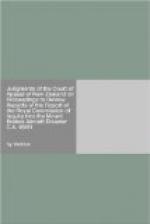We now set out the various paragraphs under attack, bearing in mind that they cannot properly be considered in isolation from the context in the report. The paragraphs vary in importance, but it is convenient to take them in the numerical order of the report. We will indicate as regards each paragraph or set of paragraphs the essence of the complaint. After doing this we will state how we propose to deal with the complaints.
Destruction of Documents
Paragraphs 45 and 54, which affect particularly the chief executive at the time of the crash, Morrison Ritchie Davis, are as follows:
45. The reaction of the chief executive was immediate. He determined that no word of this incredible blunder was to become publicly known. He directed that all documents relating to antarctic flights, and to this flight in particular, were to be collected and impounded. They were all to be put on one single file which would remain in strict custody. Of these documents all those which were not directly relevant were to be destroyed. They were to be put forthwith through the company’s shredder.
54. This was at the time the fourth worst disaster in aviation history, and it follows that this direction on the part of the chief executive for the destruction of ‘irrelevant documents’ was one of the most remarkable executive decisions ever to have been made in the corporate affairs of a large New Zealand company. There were personnel in the Flight Operations Division and in the Navigation Section who anxiously desired to be acquitted of any responsibility for the disaster. And yet, in consequence of the chief executive’s instructions, it seems to have been left to these very same officials to determine what documents they would hand over to the Investigating Committee.
These paragraphs occur in the context of a discussion of the change in the computer waypoint shortly before the flight and the failure to draw it to the attention of the flight crew. The reference to the chief executive having ’determined that no word of this incredible blunder was to become publicly known’ is, taken by itself, at least an overstatement, because in paragraph 48 the Commissioner in effect qualifies it. He says there that it was inevitable that the facts would become known and ‘perhaps’ the chief executive had only decided to prevent adverse publicity in the meantime. Clearly the airline disclosed to the Chief Inspector that the change of more than two degrees of longitude had been made in the computer early on the day of the flight and not mentioned to the crew; these matters are referred to in paragraphs 1.17.7 and 2.5 of the Chief Inspector’s report. They were matters which the Chief Inspector did not highlight; evidently he did not regard them as of major importance. For his part the Commissioner (in para. 48 of his report) states that the Chief Inspector did not make it clear that the computer flight path had been altered before the flight and the alteration not notified to the crew.




